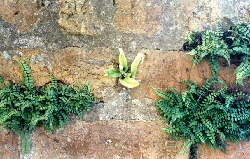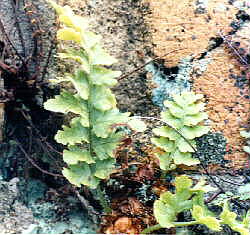Fern flora on a garden
wall
by Anne Bruce
It's amazing what you can take
for granted. I must pass the length of our garden wall on average
6 times a day and it is only recently that I have bothered to
take the time for a closer look. I had always assumed that the
many plants growing in the spaces between the bricks and mortar
all belonged to the same species.
It wasn't until I took the time
for more careful scrutiny (with rather odd looks from our
neighbours!) that I was able to distinguish a total of
five different fern species in about as many metres, all
surviving this rather spartan habitat. Thanks to some new found
skills, courtesy of a Field Studies Council course led by
pteridologist James Merryweather, I have been able to identify
our garden wall fern flora.
 |
Maidenhair spleenwort, Asplenium
trichomanes, with Hart's tongue, Asplenium
scolopendrium, in the centre. The maidenhair spleenwort is easily the
most abundant of the five species, probably making up
about 90% of the ferns found on the wall. Having looked
at the other side of the wall and corresponding walls in
other gardens, it seems that the species seems to prefer
a north facing aspect.
|
| Polypody, Polypodium
interjectum After
the Maidenhair spleenwort, this is the next most common
of the five species found. It seems to prefer the top of
the wall, rather than the mortar on the vertical surfaces
and is found on the higher section of wall, sheltered
between the two houses, rather than the length running
along the pathway.
|
 |
 |
Wall Rue, Asplenium
ruta-muritania By far the smallest of all of the ferns
found. At first glance it looks like a flowering plant,
but when you turn to the underside of the leaf, sori (which contain the sporangia) are
visible. In the photograph these can be seen on two of
the lower leaves on the right hand side.
Sporangia are the means whereby
ferns reproduce and sori are often a vital diagnostic
feature in successfully identifying ferns.
|
| Hart's tongue fern, Asplenium
scolopendrium. The Hart's tongue fern is probably one of
the easiest to identify. There only appears to be the one
plant of this type on the wall. Its long sori are
arranged in two rows, one either side of the main stem or
rachis. It was thought that this arrangement somehow
looked like the feet of centipedes and hence gave rise to
its name, scolopendrium from the Latin for
centipede, Scolopendra.
|
 |
 |
Male fern, Dryopteris
filix mas. Again
only a single specimen. Identification was difficult as
there were no sori present. However a bit of detective
work helped me make a guess when I noticed a large, well
established male fern in the border just below the wall.
I suspect that an entrepreneurial spore has managed to
get a hold in a gap in the mortar.
|
Arrangement of sori on two of the
species

back to the
text.
Some references:
- The fern guide. James Merryweather and
Michael Hill (2nd edition) 1995 Field Studies Council
- The illustrated field guide to ferns
and allied plants in the British Isles. Clive Jermy.
Josephine Camus 1991 HMSO publications
- Ferns. Roger Grounds 1974 Pelham Books
- Collins Photo Guide to ferns, mosses
and lichens of Britain. Hans Martin Jahns 1983 Harper
Collins
The inside story of inside the sori ....
Comments on the article
to the author Anne
Bruce
© Microscopy UK or their
contributors.
Please report any Web problems
or offer general comments to the Micscape Editor,
via the contact on current Micscape Index.
Micscape is the on-line monthly
magazine of the Microscopy UK web
site at Microscopy-UK
WIDTH=1
© Onview.net Ltd, Microscopy-UK, and all contributors 1995 onwards. All rights
reserved. Main site is at www.microscopy-uk.org.uk with full mirror at www.microscopy-uk.net.





